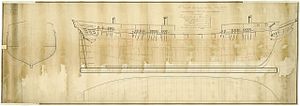HDMS Friderichssteen (1800)

Scale 1:48. Plan showing the body plan, sheer lines with inboard detail and longitudinal half breadth for Frederickstein (1807), a captured Danish frigate, as taken off prior to fitting as a 28-gun, fifth-rate frigate.
|
|
| History | |
|---|---|
|
|
|
| Name: | Friderichssteen |
| Laid down: | 22 May 1800 |
| Launched: | 11 November 1800 |
| Commissioned: | 1802 |
| Fate: | Surrendered to the British after the Battle of Copenhagen |
|
|
|
| Name: | Frederickstein |
| Acquired: | Captured from Denmark 7 September 1807 |
| Commissioned: | 1808 |
| Renamed: | Theresa, but the intent was withdrawn c.1809 |
| Fate: | Broken up June 1813 |
| General characteristics | |
| Class and type: | Fifth-rate frigate |
| Tons burthen: | 679 17⁄94 (bm) |
| Length: |
|
| Beam: |
|
| Depth of hold: | 9 ft 4 in (2.8 m) |
| Complement: | 215 in British service |
| Armament: |
|
HDMS Friderichssteen or HMS Frederichsteen was a Danish Navy frigate, built in 1800, and captured by the Royal Navy in 1807 at the Battle of Copenhagen. She was taken into service as HMS Fredericksteen (or Frederickstein) and served in the Mediterranean until being finally broken up in 1813.
Friderichssteen was a 32-gun frigate built to a design by F.C.H. Hohlenberg and launched in 1800. She had a small hull, and consequently lacked the storage capacity for long-endurance cruises to distant stations. She was laid up in 1801 and not fitted out until 1802.
At the end of March 1801 a British fleet arrived at St Thomas, in the Danish West Indies. The Danes accepted the Articles of Capitulation the British proposed and the British occupied the islands without a shot being fired. The British occupation lasted until April 1802, when the British returned the islands to Denmark.
Captain Carl Adolph Roth (1767—1834), sailed Frederikssteen to the Danish West Indies. There he also took his place on the Ruling Commission for the Danish West Indies for matters relating to the naval service. On her return voyage to Denmark in 1803, Frederikssteen carried the retiring Governor General, Major Walterstorff.
Captain Carl Wilhelm Jessen sailed Frederikssteen on her second voyage to the Danish West Indies. As with his predecessor, Part of his remit was to act for the government of the Danish West Indies on all questions of naval service and maritime defence.
During this period Frederikssteen served in home waters under two captains, each of whom died while in command. In 1805 Captain Rasmus Rafn (1764—1805), commanded Frederikssteen, which served in the Evolution (training) Squadron. His successor was Captain Michael Christopher Ulrich (1760—1806). The squadron, of ten vessels, was under the command of Rear-Admiral Otto Lutken, who raised his flag in Fredericksteen.
After the Battle of Copenhagen, the Royal Navy took control of most of the Danish Fleet. Fredericksteen was sailed to Portsmouth, where she arrived on 19 November. She underwent fitting between 3 October and 27 February 1809.
She was commissioned under the command of Captain Joseph Nourse in December 1808, who took her on convoy escort to the Mediterranean in June 1809. Captain Thomas Searle replaced Nourse and returned her to the Mediterranean in November that year.
...
Wikipedia
